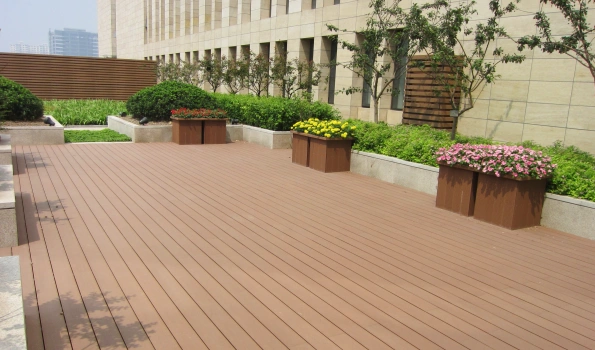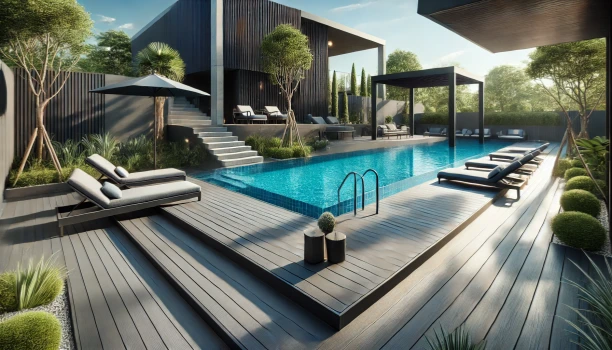Hotel Room Design Ideas
A thoughtfully designed hotel room is more than just a place to sleep—it’s an immersive experience that shapes your guest’s entire stay. From the moment they walk in, every design element you choose should evoke comfort, functionality, and a sense of place. A well-designed room can transform an average stay into an unforgettable journey, ecouraging repeat visits and positive reviews.
The hospitality industry constantly evolves as new design trends emerge. Today’s hotel rooms prioritize minimalism with functional elegance, sustainability through eco-friendly materials like Wood Plastic Composite (WPC), and personalized guest experiences powered by smart technology. These trends redefine what modern hospitality looks like while boosting your guest satisfaction.
Table of Contents
Functional Layouts
Maximizing Space with Thoughtful Furniture Placement
Smartly arranging furniture maximizes usable space without sacrificing comfort. Consider using floating beds, wall-mounted desks, and cleverly concealed storage to create an open, breathable environment. Strategic placement encourages seamless movement while preserving a cozy, intimate feel.
Multi-Functional Room Designs for Diverse Guest Preferences
Your hotel rooms must cater to business travelers, vacationing families, and solo adventurers. Use multi-functional furniture such as sofa-beds, foldable tables, and modular seating to adapt rooms to different guest profiles, ensuring comfort for every type of traveler.
Creating Zones for Work, Relaxation, and Sleep
Zoning involves dividing the room into dedicated spaces for work, relaxation, and sleep. Use partitions, rugs, and lighting variations to subtly create these zones, making the room feel spacious yet cohesive.

Aesthetic and Thematic Design
Establishing Cohesive Themes for a Unique Identity
A consistent design theme helps you create a strong brand identity. A beachside resort might embrace coastal-inspired decor, while a boutique city hotel could feature urban industrial aesthetics. This thematic approach builds brand loyalty and enhances the guest experience.
Using Color Schemes, Artwork, and Decor for Enhanced Ambiance
The right color palette can evoke specific emotions. Soft neutrals create a calming environment, while bold, jewel-toned accents add drama. Incorporate local artwork and curated decor to reinforce the room's character and connect guests to your hotel’s location.
Designing Signature Rooms for Niche Market Appeal
Target specific niches by designing signature rooms with unique themes. Consider cinema-themed suites for film lovers or adventure-themed rooms for nature enthusiasts. This creative approach attracts niche markets and generates buzz-worthy social media content.
Integration of Technology
Smart Room Features for Personalized Guest Experiences
Use smart technology to personalize the guest experience like never before. Voice-controlled assistants, touch-panel controls for lighting and curtains, and app-based room service requests make stays effortless and intuitive.
Automated Controls for Lighting, Temperature, and Entertainment
Automated systems let guests customize their room's ambiance with a single tap. Pre-programmed modes like “Relax,” “Work,” or “Sleep” adjust lighting, temperature, and entertainment settings to match their preferences.
High-Speed Connectivity and Device Charging Solutions
With the rise of remote work and digital nomadism, fast Wi-Fi is a must. Provide wireless charging stations, USB ports, and universal outlets to keep your guests connected and powered up throughout their stay.

Sustainability in Design
Eco-Friendly Materials Like Wood Plastic Composite (WPC)
WPC is an environmentally friendly material offering durability and aesthetics. It mimics the warmth of wood while resisting moisture and wear, making it ideal for your hotel’s furniture, wall panels, and flooring. Its recyclability makes it a sustainable design choice.
Energy-Efficient Fixtures and Smart Climate Control
Reduce your carbon footprint by using energy-efficient LED lighting, low-flow plumbing fixtures, and smart thermostats. These features not only save resources but also reduce operational costs over time.
Promoting Recycling and Sustainable Hospitality Practices
From providing recycling bins in rooms to using biodegradable toiletries, integrate sustainability into your daily operations. Sustainability certification programs can help market your eco-friendly commitment while attracting conscious travelers.
Comfort and Wellness Features
Premium Bedding for Ultimate Relaxation
Invest in high-thread-count sheets, plush duvets, and memory foam pillows to create a cloud-like sleeping experience. Layering textures enhances comfort and adds visual appeal, turning the bed into a centerpiece of luxury.
Air Purifiers, Blackout Curtains, and Noise Control
Ensure clean air, minimal noise, and complete darkness for better sleep. Install blackout curtains, soundproofing materials, and air purification systems to enhance rest while maintaining a luxurious environment.
Spa-Inspired Bathrooms with Wellness-Oriented Amenities
Design bathrooms as personal sanctuaries with rainfall showers, soaking tubs, and premium toiletries. Consider heated floors, ambient lighting, and relaxing scents to further enhance the wellness experience.

Local Art and Cultural Elements
Showcasing Regional Craftsmanship and Cultural Motifs
Display handmade furniture, locally sourced art, and indigenous textiles to enrich your guest experience while supporting local artisans. This authenticity connects travelers to the destination’s culture.
Collaborations with Local Artists for Unique Room Accents
Partner with local artists to rotate art installations, making each visit unique. These collaborations provide fresh aesthetics while fostering community ties.
Storytelling Through Decor for an Immersive Experience
Every design element can tell a story. Coastal hotels might incorporate driftwood art, while mountain lodges could use stone accents. Thoughtful decor creates immersive narratives that resonate with your guests.
Conclusion
From thoughtful layouts and aesthetic themes to technology integration and eco-conscious choices, modern hotel room design is about crafting unforgettable experiences. Every element—no matter how small—should work together to create comfort, functionality, and memorable stays.
As guest expectations evolve, embrace innovative designs that prioritize sustainability, comfort, and unique experiences. By doing so, you can stay ahead in a competitive industry while building lasting guest loyalty.
If you are looking for a WPC manufacturer, MATECO will be your best choice.
WhatsApp: +86-13380085620
Email: info@matecowpc.com
















